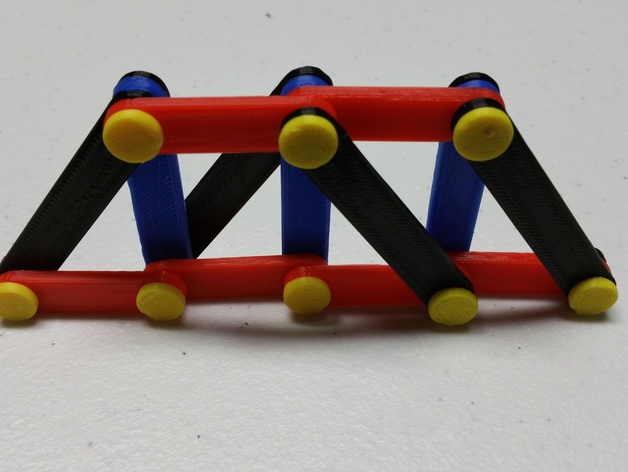
Engineering Truss Pieces for Education of Statics
thingiverse
The first component of this project (S1) is designed for educational use to show the structural rigidity of various shapes by using a pivot joint in connections. S1 consists of one part, "Truss_Arm_S1". The second section of this project (S2) is used to assemble trusses and frames to demonstrate how shapes work together to build structures like bridges and buildings. Parts are designed to be connected with pins to show that fixed joints aren't necessary for building a rigid structure. S2 consists of the rest of the parts not included in S1, offering many possibilities for customization, and I have tried to accommodate this with various pin sizes. The arm lengths are more difficult to predict, however, and I am happy to add more arms of any requested lengths. S1 consists of a single beam that has male and female ends that easily snap together to build shapes. S2 consists of several different lengths of beams as well as pins that connect through the ends of the beams to form connections. Print Settings Printer: Monoprice Select Mini Rafts: Yes Supports: No Resolution: .2 Infill: 20% Notes: Rafts may not be needed depending on your printer. Mine does not immediately begin extruding when it begins printing, so I must use rafts to guarantee that all of the print is properly printed. Post-Printing To ensure proper assembly, make sure the pins fit into the holes in the arms. This can be done by inserting a pin through a hole and then pushing it through until it reaches the other side. Lesson/Activity To start this activity, use at least four "Truss_Arm_S1" parts to demonstrate to students that triangles are stronger than other geometric shapes (I.E. square, pentagon, hexagon). Explain that this is because the ends of each arm are fixed to the others, but these connections do not offer any rotational resistance. The second phase of this activity is to show how a series of triangles can be used to build functional and rigid structures. This stage can be handled in several ways: 1: The instructor can have several models pre-made for demonstration and discussion. 2: The instructor can have kits of parts put together for students to work with and attempt to build their own trusses. 3: Students can be tasked with drawing their design on paper, and the instructor can select one or a few to assemble. Duration This activity can be very short or very long depending on how in-depth the instructor wants to go. Preparation This activity can be performed with minimal knowledge of concepts. However, for more in-depth education, students should have a basis of knowledge in geometry and vectors. For deep instruction, students should know how to apply math operations to vectors, knowledge of 2D space, and positive and negative operators. Rubric & Assessment If students are given kits to build trusses, they can be graded on several factors based on the goal of the project: -Structural integrity -Length of truss -Simplicity of design -anything else the instructor sees fit Special Notes The lengths of the arms are measured from the center of the pinholes. They are in actuality 10mm longer than indicated length. The length of pins include overhang to allow fitting of a cap to hold sections together. This extra length could allow an additional arm to be added to the pin, however the cap may no longer fit on the pin. The pin spacer and pin cap are not the same part. The pin cap is 2mm in depth and has a tighter tolerance to allow it to hold onto the end of the pins. The pin spacer is 3mm in depth to keep it the same depth as an arm, and thus make up for arms whose faces may not line up. Spacers can been seen in use in the image of the Solidworks assembly consisting of only yellow arms. The pin spacer also has a wider tolerance in the hole, similar to the hole tolerance in the arms, to allow it to easily slide onto the pins like an arm would. This also means they have the ability to spin on the pins.
With this file you will be able to print Engineering Truss Pieces for Education of Statics with your 3D printer. Click on the button and save the file on your computer to work, edit or customize your design. You can also find more 3D designs for printers on Engineering Truss Pieces for Education of Statics.
